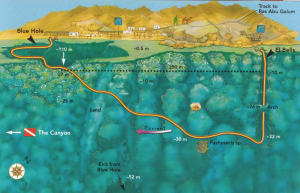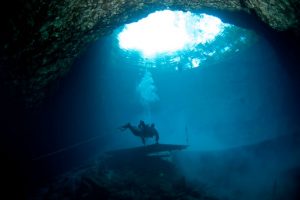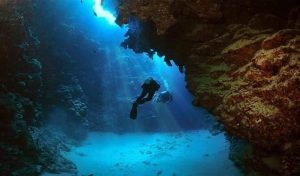Compiled by Amr Emam
The Blue Hole, a challenging diving site in the Red Sea, is a haven for adventurers.
The site is a submarine sinkhole surrounded by a 900-metre wall of coral that drops deep into the ocean.
Inside the hole, a canyon carved by an earthquake in the reef offers a dramatic landscape of light and shadow.

The Blue Hole offers a thrilling and a fascinating diving experience that never fails to captivate those who come to it.
Visits to the area have been gaining momentum in recent days, thanks to the activity the local tourism sector is witnessing after a period of slowdown.
Most of those who arrive in the area for a diving adventure also prefer to go to the Red Sea resort of Dahab.
On the south-eastern coast of the Sinai Peninsula, Dahab, a small town where culinary and Bedouin traditions outrival anything else, is becoming a favourite destination for nature, windsurfing and diving enthusiasts.
Because it is originally home to Bedouin fishermen, the once-sleepy village, which boasts some of the best beaches on the Red Sea, is a great place to fish.
It is a place full of excitement and beauty, where visitors can find whatever they love: nice beaches, great mountains and a desert that outmatches all other safari sites.
Some 80km from the better known Sharm el-Sheikh resort, Dahab is not as famous, but is as attractive and worth visiting.

It was picked by National Geographic as one of the top beaches in the Middle East.
International hotel chains and tourist facilities are concentrated in the southern part of the town, making Dahab a prime tourism destination for both budget and luxury travellers.
Authentic Bedouin lifestyle and traditions are better manifested in the northern old part of Dahab.
While constant winds offer perfect conditions for windsurfing, especially in the Laguna area, snorkelling is also a rewarding activity in Dahab with coral reefs visible at a small depth.
Although scuba diving is Dahab’s premier claim to fame, there are plenty of other activities on offer in and around the resort.
Only a 2-hour drive from Dahab’s centre, the Saint Catherine Monastery can be easily visited on a 1-day trip.

Nestled at the foot of Mount Sinai, it is one of the world’s oldest active monasteries and an important pilgrimage site.
It was built in the fifth century during the rule of the Byzantine Emperor Justinian at the place where Moses was said to have heard God speaking from the burning bush.
Also known as the Sacred Monastery of the God-Trodden Mount Sinai, the monastery is famous for its library, which contains a large collection of rare books and manuscripts.
The predominantly Bedouin part of Dahab is a gateway into the authentic life of Egypt’s Bedouins and herdsmen.
Living under austere conditions and in continual contact with nature, Bedouins developed a cuisine centred on natural substances. The Bedouins of Dahab have developed their own distinct culinary culture that offers visitors a treat of dishes.
Dates are a staple food for Bedouins. They combine them with goat milk for a nourishing mixture they eat and drink in the morning and late at night.
Bedouins bake bread using ancient and simple stoves. Their main dishes include rice, potatoes and chicken. They are famous for their coal-grilled chicken and meat balls, which they are keen to offer to visitors.

Camping out in Bedouin areas is another way for having direct contact with nature and with Bedouin lifestyle.
A Bedouin camp is just north of the Blue Hole in Ras Abu Galum Protectorate. It is possible to hike there, take a boat or join a camel safari. The protectorate is defined by its breath-taking scenery, with granite mountains plunging into the sea.
Diverse accommodation options are largely available in Dahab to suit all budgets. Prices range from $14-$60 per night.
The town is becoming one of the most important tourist attractions on the Red Sea because it has something to offer every visitor.






Discussion about this post